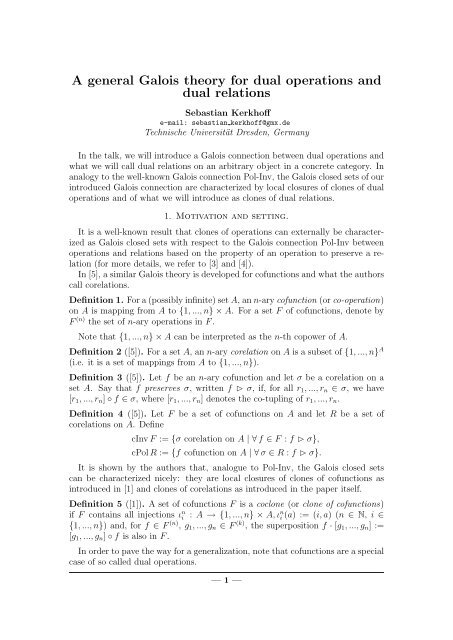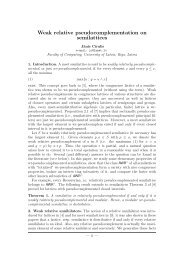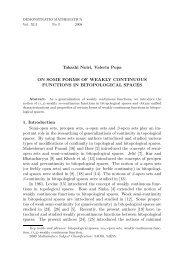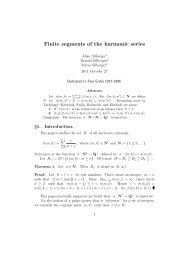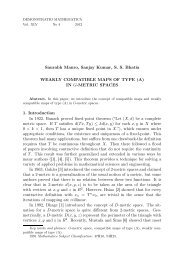A general Galois theory for dual operations and dual relations
A general Galois theory for dual operations and dual relations
A general Galois theory for dual operations and dual relations
You also want an ePaper? Increase the reach of your titles
YUMPU automatically turns print PDFs into web optimized ePapers that Google loves.
A <strong>general</strong> <strong>Galois</strong> <strong>theory</strong> <strong>for</strong> <strong>dual</strong> <strong>operations</strong> <strong>and</strong><br />
<strong>dual</strong> <strong>relations</strong><br />
Sebastian Kerkhoff<br />
e-mail: sebastian kerkhoff@gmx.de<br />
Technische Universität Dresden, Germany<br />
In the talk, we will introduce a <strong>Galois</strong> connection between <strong>dual</strong> <strong>operations</strong> <strong>and</strong><br />
what we will call <strong>dual</strong> <strong>relations</strong> on an arbitrary object in a concrete category. In<br />
analogy to the well-known <strong>Galois</strong> connection Pol-Inv, the <strong>Galois</strong> closed sets of our<br />
introduced <strong>Galois</strong> connection are characterized by local closures of clones of <strong>dual</strong><br />
<strong>operations</strong> <strong>and</strong> of what we will introduce as clones of <strong>dual</strong> <strong>relations</strong>.<br />
1. Motivation <strong>and</strong> setting.<br />
It is a well-known result that clones of <strong>operations</strong> can externally be characterized<br />
as <strong>Galois</strong> closed sets with respect to the <strong>Galois</strong> connection Pol-Inv between<br />
<strong>operations</strong> <strong>and</strong> <strong>relations</strong> based on the property of an operation to preserve a relation<br />
(<strong>for</strong> more details, we refer to [3] <strong>and</strong> [4]).<br />
In [5], a similar <strong>Galois</strong> <strong>theory</strong> is developed <strong>for</strong> cofunctions <strong>and</strong> what the authors<br />
call co<strong>relations</strong>.<br />
Definition 1. For a (possibly infinite) set A, an n-ary cofunction (or co-operation)<br />
on A is mapping from A to {1, ..., n} × A. For a set F of cofunctions, denote by<br />
F (n) the set of n-ary <strong>operations</strong> in F .<br />
Note that {1, ..., n} × A can be interpreted as the n-th copower of A.<br />
Definition 2 ([5]). For a set A, an n-ary corelation on A is a subset of {1, ..., n} A<br />
(i.e. it is a set of mappings from A to {1, ..., n}).<br />
Definition 3 ([5]). Let f be an n-ary cofunction <strong>and</strong> let σ be a corelation on a<br />
set A. Say that f preserves σ, written f ⊲ σ, if, <strong>for</strong> all r1, ..., rn ∈ σ, we have<br />
[r1, ..., rn] ◦ f ∈ σ, where [r1, ..., rn] denotes the co-tupling of r1, ..., rn.<br />
Definition 4 ([5]). Let F be a set of cofunctions on A <strong>and</strong> let R be a set of<br />
co<strong>relations</strong> on A. Define<br />
cInv F := {σ corelation on A | ∀ f ∈ F : f ⊲ σ},<br />
cPol R := {f cofunction on A | ∀ σ ∈ R : f ⊲ σ}.<br />
It is shown by the authors that, analogue to Pol-Inv, the <strong>Galois</strong> closed sets<br />
can be characterized nicely: they are local closures of clones of cofunctions as<br />
introduced in [1] <strong>and</strong> clones of co<strong>relations</strong> as introduced in the paper itself.<br />
Definition 5 ([1]). A set of cofunctions F is a coclone (or clone of cofunctions)<br />
if F contains all injections ι n i : A → {1, ..., n} × A, ι n i (a) := (i, a) (n ∈ N, i ∈<br />
{1, ..., n}) <strong>and</strong>, <strong>for</strong> f ∈ F (n) , g1, ..., gn ∈ F (k) , the superposition f · [g1, ..., gn] :=<br />
[g1, ..., gn] ◦ f is also in F .<br />
In order to pave the way <strong>for</strong> a <strong>general</strong>ization, note that cofunctions are a special<br />
case of so called <strong>dual</strong> <strong>operations</strong>.<br />
— 1 —
Definition 6. Let X be a category with finite, nonempty coproducts <strong>and</strong> let<br />
X ∈ X . An n-ary <strong>dual</strong> operation over X is a morphism from X to the n-th<br />
copower of X. Denote the set of all n-ary <strong>dual</strong> <strong>operations</strong> over X by O (n)<br />
X <strong>and</strong> set<br />
OX := <br />
n≥1 O(n)<br />
X .<br />
The notion of <strong>dual</strong> <strong>operations</strong> <strong>general</strong>izes the notion of cofunctions, since, in the<br />
category of sets, the <strong>dual</strong> <strong>operations</strong> on a set X are precisely the cofunctions on<br />
X if we identify the n-th copower of X with {1, ..., n}×X. We can also <strong>general</strong>ize<br />
the notion of coclones.<br />
Definition 7. Call a set F of <strong>dual</strong> <strong>operations</strong> over X a clone of <strong>dual</strong> <strong>operations</strong><br />
over X, written F ≤ OX, if F contains all the injection morphisms from X<br />
to finite copowers of X <strong>and</strong>, <strong>for</strong> f ∈ F (n) , g1, ..., gn ∈ F (k) , the superposition<br />
f · [g1, ..., gn] := [g1, ..., gn] ◦ f is also in F . All clones of <strong>dual</strong> <strong>operations</strong> over X<br />
<strong>for</strong>m a lattice with respect to inclusion. Denote this lattice by LX.<br />
It was shown in [2] that, <strong>for</strong> every finite centralizer clone C (i.e. C =<br />
<br />
n≥1 Hom(An , A) <strong>for</strong> some finite algebra A), there exists a category X of algebraic<br />
gadgets such that the ideal 〈C] in the lattice of clones over A is isomorphic<br />
to the lattice LX of clones of <strong>dual</strong> <strong>operations</strong> over some object X ∈ X . However,<br />
LX is a lattice of coclones if <strong>and</strong> only if C is isomorphic to the centralizer clone<br />
of a boolean algebra, which is obviously a very uncommon occurrence. In all<br />
other cases, X is an object with more structure <strong>and</strong> the coproducts in X are not<br />
the disjoint union (see [2] <strong>for</strong> more details). Thus, the <strong>Galois</strong> <strong>theory</strong> proposed<br />
in [5] is only as <strong>general</strong> as the usual <strong>Galois</strong> <strong>theory</strong> restricted to <strong>operations</strong> over<br />
boolean algebras. There<strong>for</strong>e, it is a natural wish to apply the notion of <strong>relations</strong>,<br />
preserving <strong>and</strong> all the results of the corresponding <strong>Galois</strong> connection <strong>for</strong> all <strong>dual</strong><br />
<strong>operations</strong> <strong>and</strong> something that will then be a <strong>dual</strong> relation.<br />
2. Pol-Inv<br />
Inspired by this wish, the talk will outline a <strong>general</strong> <strong>Galois</strong> Theory <strong>for</strong> <strong>dual</strong><br />
<strong>operations</strong> <strong>and</strong> what we will call <strong>dual</strong> <strong>relations</strong> on an arbitrary (not necessarily<br />
finite) object X in an arbitrary concrete category X with finite, nonempty coproducts.<br />
For the case that X is the category of sets, it will coincide with the<br />
<strong>Galois</strong> <strong>theory</strong> in [5].<br />
When we talk about concrete categories, we will use the convention of assuming<br />
that the objects are sets with some additional structure <strong>and</strong> the morphisms are<br />
structure preserving maps between them (<strong>for</strong>mally, the objects <strong>and</strong> morphisms<br />
in a concrete category can only be interpreted in this way but do not necessarily<br />
have to be of this <strong>for</strong>m).<br />
Denote by X ∗ the category we obtain from X in the natural way if we identify<br />
all objects that are isomorphic to each other (the reason <strong>for</strong> this step will be<br />
discussed in the talk).<br />
Definition 8. Let Y ∈ X ∗ be finite. A <strong>dual</strong> relation of type Y on X is a subset<br />
of Y X . Denote the set of all <strong>dual</strong> <strong>relations</strong> of type Y on X by R (Y)<br />
X . For k ∈ N,<br />
<br />
let R (k)<br />
X :=<br />
Y∈X ∗ ,|Y|≤k<br />
R (Y)<br />
X <strong>and</strong> RX := <br />
k≥1<br />
R (k)<br />
X .<br />
— 2 —
Definition 9. Let σ ∈ R (Y)<br />
X <strong>and</strong> let f be an n-ary <strong>dual</strong> operation over X. We say<br />
that σ is invariant <strong>for</strong> f or that f preserves σ, written f ⊲ σ, if [r1, ..., rn] ◦ f ∈ σ<br />
whenever r1, ..., rn ∈ σ.<br />
We define clones of <strong>dual</strong> <strong>relations</strong>.<br />
Definition 10. A set R ⊆ RX is called a clone of <strong>dual</strong> <strong>relations</strong> on X, written<br />
R ≤ RX, if ∅ ∈ R <strong>and</strong> R is closed under <strong>general</strong> superposition, i.e. the following<br />
holds: Let I be an index set, σi ∈ R (Yi) (i ∈ I) <strong>and</strong> let φ : Z → Y <strong>and</strong> φi :<br />
Z → Yi be morphisms where Yi, Z ∈ X ∗ <strong>and</strong> Yi finite. Then the <strong>dual</strong> relation<br />
φ<br />
(φi)i∈I (σi)i∈I defined by<br />
φ<br />
(σi)i∈I :=<br />
(φi)i∈I<br />
φ<br />
(φi) (σi) := {φ ◦ r | ∀ i ∈ I : φi ◦ r ∈ σi, r ∈ Z X }<br />
belongs to R.<br />
Definition 11. We define the operators Inv : P(OX) → P(RX) <strong>and</strong> Pol :<br />
P(RX) → P(OX) as follows: For F ⊆ OX <strong>and</strong> R ⊆ RX, set<br />
Inv F := {σ ∈ RX | ∀ f ∈ F : f ⊲ σ},<br />
Pol R := {f ∈ OX | ∀ σ ∈ R : f ⊲ σ}.<br />
In this setting, we will be able to find a <strong>dual</strong> counterpart to almost every<br />
definition, lemma, proposition or theorem given in the context of Pol-Inv (see <strong>for</strong><br />
example [4] <strong>and</strong> [3]).<br />
Definition 12. Let F ⊆ OX, R ⊆ RX <strong>and</strong> let s ≥ 1. We define the following<br />
local closure operators:<br />
s-Loc F :={f ∈ O (n)<br />
X | n ≥ 1, ∀ r1, ..., rn ∈ Y X , Y ∈ X ∗ , |Y| ≤ s :<br />
∃ f ′ ∈ F : [r1, ..., rn] ◦ f = [r1, ..., rn] ◦ f ′ },<br />
s-LOC R :={σ ∈ RX | ∀B ⊆ σ, |B| ≤ s : ∃ σ ′ ∈ R : B ⊆ σ ′ ⊆ σ}.<br />
Furthermore, let Loc F := <br />
s-Loc F <strong>and</strong> LOC R := <br />
s-LOC R.<br />
s≥1<br />
As the most important result, we can characterize those subsets F ⊆ OX <strong>and</strong><br />
R ⊆ RX which can be represented as Pol R ′ <strong>and</strong> Pol F ′ <strong>for</strong> some R ′ ⊆ RX <strong>and</strong><br />
F ′ ⊆ OX, respectively.<br />
s≥1<br />
Theorem 13. For F ⊆ OX, the following are equivalent:<br />
(1) F ≤ OX <strong>and</strong> Loc F = F<br />
(2) F = Pol Inv F<br />
(3) ∃ R ⊆ RX : F = Pol R<br />
Theorem 14. For R ⊆ RX, the following are equivalent:<br />
(1) R ≤ RX <strong>and</strong> LOC R = R<br />
(2) R = Inv Pol R<br />
(3) ∃ F ⊆ OX : R = Inv F<br />
— 3 —
If all finite copowers of X are finite (which happens in most of the usual categories<br />
as soon as X is finite), we have Loc F = F <strong>and</strong> LOC R = R <strong>for</strong> all F ⊆ OX<br />
<strong>and</strong> R ⊆ RX. Thus, in this case, the <strong>Galois</strong> closed sets are exactly the clones of<br />
<strong>dual</strong> <strong>operations</strong> <strong>and</strong> the clones of <strong>dual</strong> <strong>relations</strong>, respectively.<br />
We end the talk with discussing possible applications of this <strong>theory</strong>.<br />
References<br />
[1] Csákány B. : Completeness in coalgebras, Acta Sci. Mat.48 (1985), pp. 75-84.<br />
[2] Maˇsulović D. : On <strong>dual</strong>izing clones as Lawvere theories, International Journal of Algebra<br />
<strong>and</strong> Computation 16 (2006), pp. 675-687.<br />
[3] Pöschel R., Kaluˇznin L.A. : Funktionen- und Relationenalgebren, Deutscher Verl. der Wiss.,<br />
Berlin, 1979.<br />
[4] Pöschel R. : Concrete representation of algebraic structures <strong>and</strong> a <strong>general</strong> <strong>Galois</strong> <strong>theory</strong>,<br />
in: Contributions to General Algebras, Proc. Klagenfurt Conf., May 1978, Verlag J. Heyn,<br />
Klagenfurt, Austria, 1979, pp. 249-272.<br />
[5] Pöschel R., Rössiger M., A <strong>general</strong> <strong>Galois</strong> <strong>theory</strong> <strong>for</strong> cofunctions <strong>and</strong> co<strong>relations</strong>, Algebra<br />
universalis 43 (2000), pp. 331-345.<br />
— 4 —


